This is year 1 of that adventure.
Here's how it looked just before we started (view from spillway at far end):
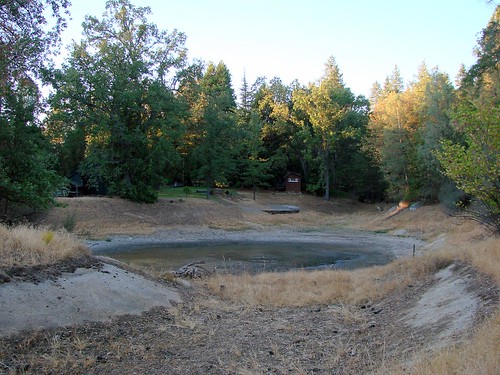
Also before we started (view from "beach" looking towards spillway):
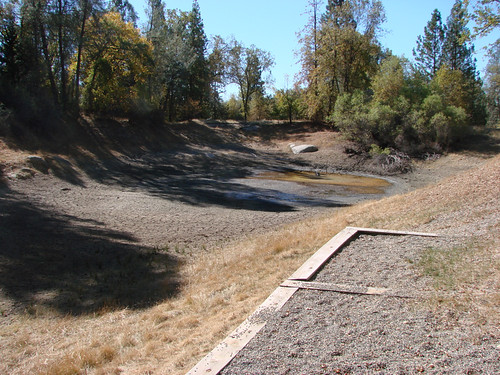
And the upper pond and creek behind the house:

Not pretty. In fact, you know it's really bad when a group of teens decides to play bocce ball on the dry, hard-packed bottom.
Pond history
Our pond is embankment-style, dug into the bed of a seasonal creek that's fed by rain and snowmelt. It sits at 3,100 feet in the Sierra near Mariposa and Yosemite. We don't know when it was originally dug (the property was homesteaded in the late 1800's), but the cement spillway has "Nov 1967" written in it. It's quite likely it was built as part of the Farm Pond program developed during the FDR administration by the USDA's Soil Conservation Service, and the U.S. Fish and Wildlife Service. During the 40s to 80s, over 2 million ponds were dozed in America through this program and its tax subsidies. It was a smart idea - the ponds store water for irrigation and livestock, and support fish and fowl as food supplements. They also act as fire breaks, add moisture to the air, and improve the climate (think Dust Bowl). And, they're a blast for recreation.
Most of the year, our pond is two. A small upper one by the house where the creek runs, and a large 1/2-acre+ lower basin that looks like a 200-foot bota bag dangling south. The break between the two is a small waterfall by a little cabin. However, in the winter when the creek runs and the ponds fill and overflow, the falls disappear and the upper and lower basins connect into one long body of water with a surface area of about 1 acre, and a deep end that's near 17 feet. (trivia: it's only a lake once it's larger than 5 surface acres). Fill up usually happens by the end of February. The water sits thereafter, the level slowly dropping as seepage and evaporation take their toll. Occasionally, rain picks it up an inch or three. Once it drops a foot, the pond breaks in two again - lower and upper - and the falls flow. Pre-rework, a drought season would see the pond near dry by fall. In wet seasons, it looks great all year. But we don't seem to be having lots of those.
Full pond (as seen from spillway):
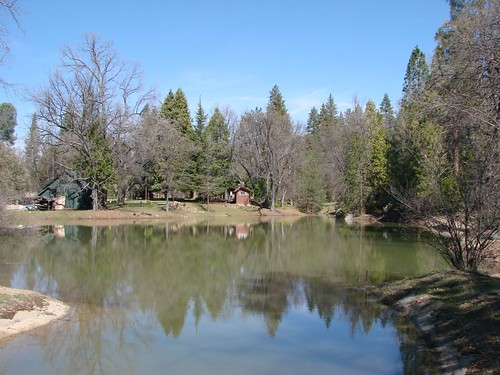
Full pond (as seen from above beach, which is 3 feet under water):

Ponds connect when water covers falls (view from above upper pond):
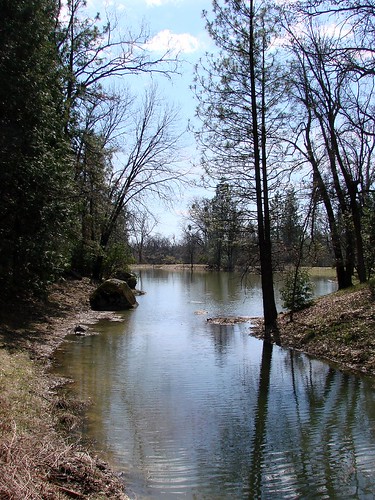
Same view once the water drops a foot and the ponds disconnect:

Reshaping & sealing
The first thing to nail down was seepage. I.e., with ponds, you start from the bottom up. We began by grading the pond with some heavy equipment to refine the bottom and sides (2/1 slopes reduce erosion and hide water drops). During this shaping we removed some unhealthy trees, and brought in rocks and boulders to add interest, define the falls, and create future animal habitats. We also buried a run of pipe from the lower basin to the upper pond, and up the creek 100 feet. This'll allow us to recirculate water from the lower pond to just above the upper pond, which will become a wetland filter for the water running back down through it (once plants have grown in). We then put down 2 lbs of Bentonite per square foot and packed it with the local clay-rich topsoil (and a sheep's foot). Bentonite is a clay made of particles that grow to 10x their dry size once they get wet. The combination of packing it into every nook & cranny, and this swelling creates a seal that prevents seepage.
Bentonite sucks! (this used to be powder):
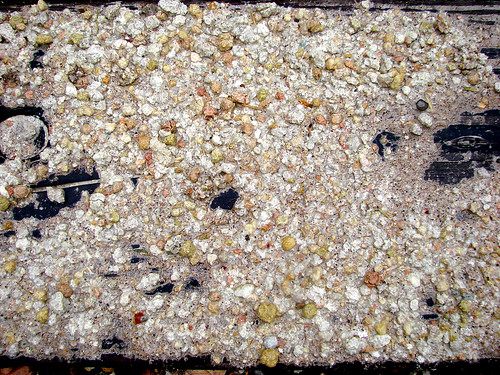
Reshaping lower pond (view from above beach):
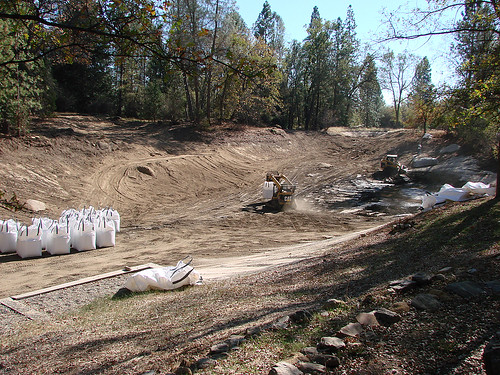
Reshaping upper pond and packing in Bentonite:
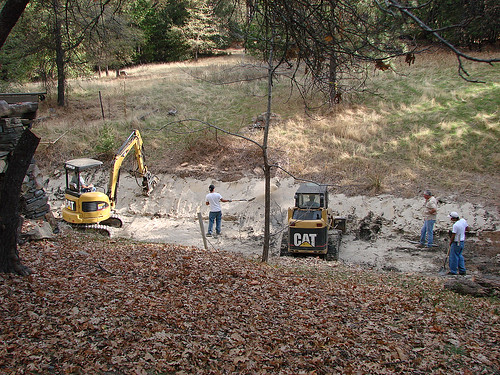
Pond just afterwards (view from spillway end):
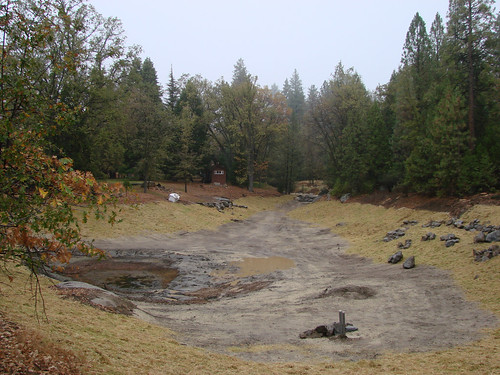
Once the pond was shaped and sealed, it started filling right away. I.e., we unknowingly waited until the last minute because the rains came the next day. By the beginning of March it was full. While it was filling, we tucked into a few peripheral projects...
Recirculating water for filtration & aeration
As mentioned, we decided to put in 2 pump-driven recirculation lines, one from the deep end of the lower basin to the middle of the upper pond, and another from there to a hundred feet up the creek. The pumps push water up the buried pipes, the water bubbles up in the upper pond and creek, and gravity brings it back down the creek and falls to the lower pond. The hope is that this action will clarify and aerate (add oxygen to) the water as it tumbles along and passes through the wetland filter provided by the cattails and reeds of the shallow upper pond. A bigger hope is that this refreshing recirculation will cut back on the mosquitoes and encourage critters we like, such as dragonflies, that are the top predator of said pesties. Our experience this summer seemed to bear these hopes out - the water clarified as the wetland filter grew in, and biter activity around the house and pond was way down - perhaps thanks to the many colorful dragonflies. We also found out that it's super cool to have the faux creek running - it sounds wonderful and attracts all sorts of interesting visitors.
For the pond size and distance and head pressure we're pumping, the calcs suggested a 1 HP pump for each leg - lower to upper, and upper to up-creek. Instead of a single 1 HP pump, we went with two 1/2 HP pumps for each. Gives us more control (can run 1 or 2), and redundancy if a leg breaks or we want to do maintenance. Also, the two modern high-efficiency 1/2 HP pumps we found together use less power than a single 1 HP pump! We have the pumps hooked to timers, and are finding that even a single 1/2 HP pump creates enough recirc flow to drive the soothing creek and falls and slowly filter and clarify the water. And boy are they quiet.
Pumps that push water from the lower to upper pond:

25-foot floating dock
We also decided to put in a floating dock to make it easier to boat and fish and swim and such. It wasn't cheap, but in the hope for long life and low maintenance, we went with the floating dock hardware designed for the U.S. Army Core of Engineers. It's like adult tinker toys for floating dock and bridge building. I.e., you can't look at it without grunting. Only things I'd do different is make it wider. Width = stability (think standing in a canoe versus on a raft). At 5 feet wide it slews a bit. Nothing a practiced drunk can't handle though. We can easily compensate with tie downs, but if it was 8 feet, it would prob be much more stable. Also, it's a little high off the water for feet dangling - recessing the floats would have solved that.
Finished dock (and unfinished photographer):
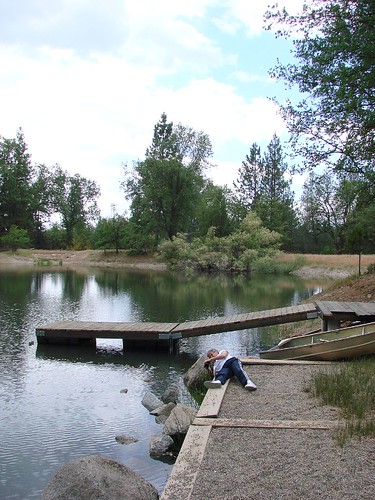
Logjams and rocky shoals
Algae feed on phosphorus and tend to grow on surfaces before growing in open water. By creating more surfaces with rocks, logs and brush, we cultivate attached algae to grow and use up the phosphorus in the water before any floating algae can form. The attached algae also oxygenate the water, and are a vital part of the food chain for a broad variety of pond zooplankton called "scrapers" that graze on them (and then feed fish and so on). Back in the macro world, bigger critters, such as frogs and lizards, live under the logs, while other beasties, such as squirrels and woodpeckers, use them to access the water. I.e., logs, brush and rocks in the water are a good thing.
We didn't get any open water algae this year. Dunno if that's just because it's year 1. The water clarified during the summer, finally getting so clear we could easily see over 10 feet down to the bottom.
Testing the water
To make sure everything we're doing is producing good water for both humans and critters, I decided to start testing it. By combining a couple of well and home water test kits with a kid's science experiment kit, I'm now able to test Iron, Lead, Manganese, Nitrates, Chlorine, pesticides, coliform bacteria, pH and oxygenation. So far, tests show the water to be excellent and drinkable by all. The large number of frogs are good supporting data for these results.
Restocking the fishies
To get some fish going in the pond again (and keep the blue heron & kingfishers happy), our local stocker (that works for Dept. of Fish & Game) brought us 170 largemouth bass fingerlings and 1600 bluegill fingerlings (a 10:1 ratio for bass to feeders is recommended by the USDA). In theory the bass will grow 5-6" in a year and the bluegill 3-4", and both should start spawning this Spring. We may also add more varieties of fish and even some of the local crayfish. Perhaps Sacramento Black Fish for filtering, and Mosquito Fish for... hmmm... can't remember...
That's year 1. Whew. And the results? Pretty stellar so far. As Spring sprung, native greens exploded out of the pond perimeter, and animals started moving in. Tadpoles blackened the water. One poor turtle showed up too early though, and sat all alone on a rock overlooking a full pond with nary a fishy, frog or fly to call friend or food. He'll be back. Through summer the cattails and reeds matured, dragonflies ruled the air, and bullfrogs dotted the shore. Native wetland wildflowers popped up here and there. Swimming rocked.
That should leave evaporation as our main challenge to stability. Because of the sweltering summers, evap rates can be quite high in the low Sierra - as much as 1/2 inch per surface acre per day in the peak of summer. At near an acre, our pond can drop 16 inches in a month, and 6-8 feet in a dry year from evap alone (i.e., no rain Mar-Nov). That's now sustainable, but not ideal. So, we're looking at ways to add water by tapping into some of the old springs and wells on the property. In the meantime, we can add water from the prodigious house well, but running the pump ain't green, so we want another solution. A solar-powered well pump might prove perfect, so we're exploring that too.
I'll finish with a small collage of the pond post-rework, and the fun, flora and fauna it attracted. You can also check out my full album of pond pics on flickr.




















Oh, and a parting poem...
I'm going out to clean the pasture spring
I'll only stop to rake the leaves away
(And wait to watch the water clear I may)
I shan't be gone long - you come too.
- Robert Frost
==========
Resources:
- USDA Natural Resources Conservation Service (NRCS) - Agricultural Handbook Number 590: Ponds - Planning, Design, Construction
- State of California Dept. of Fish & Game - Information Leaflet Number 23: Farm Fish Pond Management in California
- Steve McComas - Lake and Pond Management Guidebook
- Tim Matson - Landscaping Earth Ponds
- Gene Logsdon - The Pond Lovers
- Dock Builders Supply

It was a smart idea and pools of water storage for irrigation, livestock fish birds, support and dietary supplements.
ReplyDeleteWaterfall Pumps